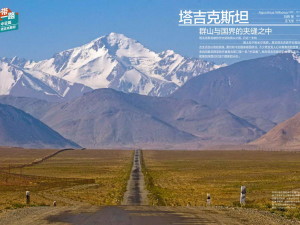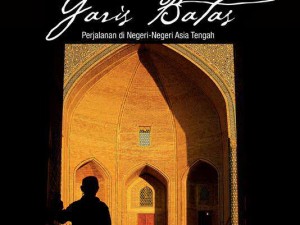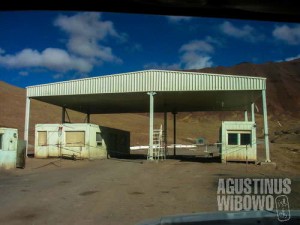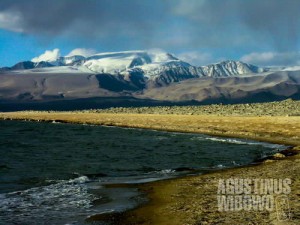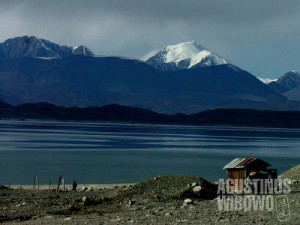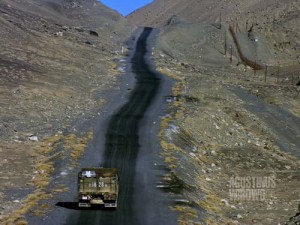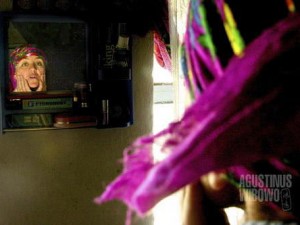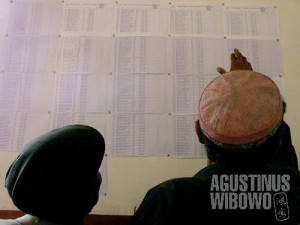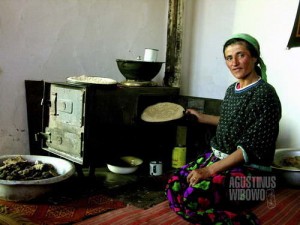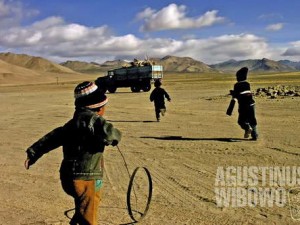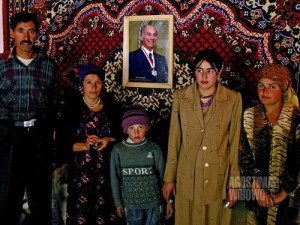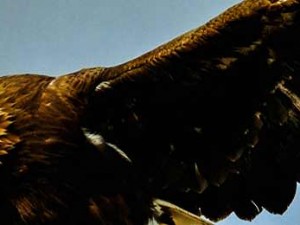Tajikistan
My article in Chinese National Geography, edition October 2015. This is a special edition focusing on China’s grand project: One Belt One Road, a.k.a. the “New Silk Road”, with some focus articles from the Silk Road countries, especially in Central Asia. In this edition, I have contributed two articles: Tajikistan and Afghanistan’s Wakhan Corridor. 塔 吉克斯坦被称作中亚的高山之国,它近一半的国土位于帕米尔高原。其实塔吉克族并非是自古生活在山地的民族,面对如今的国家版图状况,不少塔吉克人心中有难 言的苦衷。来自印度尼西亚的作者奥古斯汀是一名“中亚通”,他对塔吉克斯坦的考察和采访,能够加深我们对这个国家的认识。 撰文Agustinus Wibowo[印尼] 摄影刘辉 等 翻译王飞宇 令塔吉克人自豪的两座古城,如今却位于乌兹别克斯坦的境内 [read more]
Garis Batas – Perjalanan di Negeri-Negeri Asia Tengah (Borderlines)
My second published travel writing book, on journey to Central Asian countries (The “Stans”). Indonesian language. Borderlines – Journey to the Central Asian States Everyday, Afghan villagers stare to “a foreign country” which is just a river away. They look at passing cars, without even once experiencing sitting inside the vehicles. They look at Russian-style villas, while they live in dark mud and stone houses. They look at girls in tight jeans, while their own women are illiterate and have no freedom to travel. The country across the river seems magnificent—a magnificent fantasy. The same fantasy brings Agustinus Wibowo travel to the mysterious Central Asian states. Tajikistan. Kyrgyzstan. Kazakhstan. Uzbekistan. Turkmenistan. The “Stan brothers”. This journey will not only bring you step on snowy mountains, walk accross borderless steppes, adsorbing the greatness of traditions and the glowing Silk Road civilization, or having [read more]
Globe Asia (2007): Solo Travel – Wealth of Experience
SOLO TRAVEL: WEALTH OF EXPERIENCE Holiday season is approaching and perhaps it’s time to do something different. Try solo traveling. The trip might be more costly than joining an arranged tour but the joy of discovery is more than adequate reward, say Agustinus Weng and Nefransjah. BY MARY R. SILABAN Flying business class, staying at five-star resorts, joining a flock of fellow tourists in an air-conditioned bus and eating a sandwich while visiting an ancient temple is not how Nefransjah and Agustinus Wibowo like to travel. The two independent travelers, or what people usually call backpackers, demand the freedom to add their own flavor. While on the road, Nefransjah tries to be as close as he can to the street, and that means taking as few air flights as possible and avoiding the usual tourist sites. “1 want to absorb all the local ambience,’ says the 37 year-old. For Agustinus, 26, there’s no thought of joining a group tour. “When we travel solo, we have [read more]
Osh – Goodbye Tajikistan
Finally… the truck. And a new country Maybe it was because of the falling stars. When I woke up very early, about 7, as I couldn’t sleep at all the whole night, I saw two trucks were having custom check in Khurshid’s border post. These were trucks owned by Kyrgyz drivers from Kyrgyzstan. My Kyrgyz host helped me with a negotiation (‘chakchak’ in Tajik) with the drivers, and they agreed to take me as far as Sary Tash for 20 Somoni. Sary Tash would be the first Kyrgyzstan city to be approached from here. I was not the only passengers of the trucks. There was already an old Kyrgyz man with his family. The trucks were taking sheep and yaks. The drivers didn’t have document to transport these animals to Kyrgyzstan, so the numerous checkpoints along the road had to be really fuelled by money to smooth up the way. This is the way the business done. Tajikistan’s Pamir region is famous of its animal products, raised by the Kyrgyz and Pamiri Tajik herders. Animals are brought [read more]
Kara Kul – Get Me Outta Here!!!
It;s beautiful. It’s surreal. But I wanna leave! I really regretted to refuse yesterday’s offer to take the truck lift to Kyrgyzstan. My Tajik visa is going to expire tomorrow (November 4) and I just found on Fridays (like today), transport is extremely difficult. The day is very cold and windy. I have to stand next to the main road, waiting for any vehicles. The first truck passes at 12 and it was full of passengers. The next two hours there was no vehicle at all passing the highway. Khurshid takes me to local stalovaya (canteen) and asks the girl to give me the best food. Khurshid promises to treat me, ‘a poor spion (spy) without money who has to travel on trucks’. I asked how much. The girl said, “Beker! Beker!” I jumped as I was surprised. This happened to be a fatal language misunderstanding. In Tajik Persian, the language which I understand, it means ‘no penis’. I explained to the girl that I had, but she only speaks Kyrgyz, and doesn’t understand my [read more]
Karakul – the Giant Death Lake
The giant death lake of Kara Kul. Karakul in Kyrgyz language means ‘black lake’. The lake itself is not black. In fact, this huge water body was deep blue when the sky is friendly, and turns to be grey when the sun chooses to hide behind the clouds. But the life is as dark as its name. There is no life at all in this huge lake. The lake has high concentration of salt. But despite of the salt, the lake also freezes in winter. The village next to the lake, bears the same name, is a Kyrgyz settlement with only one Tajik man inhabitant – a policeman. I was supposed to stay with the Tajik policeman, as it’s the only chance for me to communicate with my Persian knowledge. But when I arrived there, the Tajik man had left to Khorog.I stayed with a Kyrgyz family, an Acted-arranged guest house. They don’t speak Tajik, but the husband know little bit and can sing the national anthem proudly, “Zindabosh e vatan Tajikistan e azadi man (Long Live o Fatherland, My Free Tajikistan!)” He [read more]
Karakul – Out of Murghab
A new day, and a new month, starts in Murghab The new month has just started, and I have only 4 days left on my visa. I met these two guys in the bazaar of Murghab, one with visa expiring today (November 1). The guys were from America and Israel, and they have been waiting for onward travel to Kyrgyzstan. They were there in the bazaar yesterday but failed to depart. Today is the second day (and supposed to be the last day) attempt. Murghab is somehow a depressing place to wait for transport. As now the oil price has skyrocketed, one’s a month salary is only enough to cover the distance from Murghab to Osh or to Khorog in a public transport for one time. People don’t travel anywhere. There are many drivers but not passengers. The drivers hang around the bazaar the whole day to get passengers, and except the two travelers, and me, there is nobody else to share the cost. Some drivers even didn’t have petrol for their vehicles. The cost is always calculated in terms of liters of [read more]
Murghab – Life in Murghab
A morning greetings from Murghab Murgab (Murghab) was promising when it was built. It was a new Russian settlement built as frontier city of Pamir. The highway connecting the isolated mountains to the lowland towns was supposed to bring wealth to the nomadic community. Life had changed ever since. A town was built on the top of mountains. People were educated. Frontier military checkpoints were enforced. But how is life now, after Tajikistan gained independence from the USSR and civil war took place in the new country? The hope of the future had turned to be a bad fate. I had got a chance to know Gulnara, a 54 year old woman working as a primary school teacher in Murgab. Gulnara is the younger sister of Khalifa Yodgor from Langar. But the last time she saw him was 2 years ago. “It is too expensive to go there,” said her. Langar is not too far from Murgab. It is around 250 km only, but the public transport there is very rare and expensive. At present, Murghab-Langar cost 50 [read more]
Murgab – 100 Questions and Answers about Tajik Presidential Election
Browsing through the list of candidates A friend of mine, Rosalina Tobing, works in social political section of the Embassy of Republic of Indonesia in Tashkent, Uzbekistan. She often gets assignments to make reports about political moments in Central Asia. These days, the thing which people in Tajikistan like to talk about was the presidential election which is going to happen on November 6, 2006. Besides of this, people in GBAO also like to know more about the spiritual leader Aga Khan who visit the area together with the president. Rosalina asked me to get a book for our embassy’s reference, entitled ‘100 Questions and Answers about Tajikistan Presidential Election”. The book is as mythical as the 1001 Nights. I couldn’t find anywhere in Tajikistan (maybe because I always bumped into wrong places all time) but in election booths in the villages in GBAO. First I saw the book in the community hall , which was magically turned to be an election booth, in Vrang. I tried to ask [read more]
Murghab – The Dudkhoda’s Family
Boys of Murghab, in front of Tajik banner with the tricolor flag and coat-of-arms, of which important element is a snow mountain “Pamir will be better…. Pamir will be better….” – Dudkhoda My first impression of this 39 year old Tajik man was really not so good. this man tried to hug me and kiss me when I was sleeping next to him under the same blanket on the floor in the Kyrgyz restaurant in alichur packed by the Kyrgyz drivers. He also made me to pay his bills in the restaurant. But later I found that he had story worth to tell. He arranged for me a seat in the Kyrgyz truck, along with him, who returned to his home in Murghab. He was actually a passenger of the truck, not being able to pay the ride with money but offered the drivers a dinner in his hosue in Murghab. I came along with him, sitting along the way to Murghab (100 km) for free. Just near Murghab, there were two military checkpoint. The Kyrgyz drivers failed to do registration and they became [read more]
Alichur – Kyrgyz Community
The steppe of Alichur Actually I planned to stay for some more days in Langar, but I have heard that the transport onward to Murghab would be very difficult to get. This was caused by the high oil price, so people couldnt afford anymore to travel, and instead of going to smaller and hopeless Murghab they opted to bigger Khorog. Suddenly, even when I was not prepared yet, there was a passenger jeep going to Murghab on 27th. The khalifa told me if I didnt take this car, the next transport might be a month after. I had no choice but to leave Langar. The road continued to east along the river bordering Afghanistan. Afghanistan on that side of the river had no more motorable road as it already entered the Big Pamir area. Sometimes caravans of Bactrian camels were visible along the dirt road on that side of the river, while we were travelling in a russian jeep. World differed more than a century in the two sides of the river, which was very shallow and narrow in winter. It should be very [read more]
Langar – Connecting Afghanistan
Yodgor family. Aga Khan portraits always decorate the houses of Ismaili families in Tajikistan Pamir. Three months ago, on July 31st exactly, I came to this little bridge. That time I was coming with the Shah (the King) of Panjah, district officials of Khandud, and Afghan soldiers. At that time, we were there to see the opening of the bridge and overwhelmed by the optimistism of the desperate Wakhi people from Afghan side, about the change of their future by this new border. Today, I am at the other side of the bridge, seeing the barren hills of Afghanistan with all of its hopes, from Tajikistan side, with Mulloev Yodgor Dildorovich, the khalifa (religious leader)-cum-teacher of Langar. Yodgor was among those who were overwhelmed by millions of mixed feelings when the border was opened, only for one day. On August 1, 2006, there was held an Afghan bazaar just next to the bridge in Langar side. The people from Afghanistan Wakhan Corridor were coming from all directions, from as far as [read more]
Vrang – Life in Vrang
Green, peaceful, and lazy … Vrang Travelling in Tajikistan side of the Wakhan Corridor was as difficult as in Afghanistan side. Public transport was rare, the oil price got higher as the altitude got higher. It was 3.50 Somoni per liter of petrol here. No one was sure when the coming transport would come. And even when it came, it was often full, no space to share. It was indeed luck to be able to travel according to what one has planned. I was patient enough even though I worried about my short visa. Dr Akhmed was a doctor in Tughoz. I was waiting for transport to Vrang, 5 km away from tughoz, in his hospital. As the main doctor in this village, he earned only 50 Somoni per month. You would go nowhere with that amount of money in Tajikistan. But everybody was optimistic with his life. Working with little income was still better rather than begging on the streets. I have heard beggars in Jakarta could earn at least 60 dollars per month, about 280 Somoni, or 4 times higher than [read more]
Tughoz – Aliboy Family Aliboy family
The Aliboy family His name is Tuloev Aliboy Jumakhanovich, an unemployed man who sometimes work as driver, 33 years old. He greeted me, “We, Ismailis, dont go for hajj in Mecca. We dont waste our money for hajj. But our leader says, providing shelter and food for poor traveller, the mosafers, that is our hajj pilgrimage.” That is the reason of the hospitality of the Ismailis. No matter that there is no even wheat to make bread, being hospitable to a guest is compulsory. Aliboy sheltered me in his traditional house. There were his old father, Jumakhan, 72 years old, the old mother, sisters, cousins, and children in his little house. People of the Pamir are said to have long ages, like Jumakhan’s grand father who lived until 120 years old of age. Maybe it was because of the pure water. Aliboy had no job, even though he had a car. Here we could observe how live reduced dramatically to its modest form since the breakaway of the USSR. From a car owner to be an unemployed [read more]
Ishkashim – Bodurbekov Family
Alisher (a.k.a Muhammad Bodurbekov) with his cousin “Now you are not guest anymore. You are part of our family. Welcome!” – Muhammad Bodurbekov Since the first minute I arrived in Ishkashim, I was impressed by the hospitality of the people in the Wakhan Valley. I was invited by Muhammad Bodurbekov, 29, to his house in the village. Muhammad, alias Alisher, worked in Dushanbe in Aga Khan’s NGO, MSDSP. He had classes in Khorog and he then had chance to see his family in Ishkashim. He spent a month in the UK for his higher education, and he still maintained his British accent. Alisher was an educated professional and he had so many things to discuss. So before starting, let’s sit on the ‘kurpacha’, the guest welcome matress, which Alisher laid between the pillars of Ali and Muhammad. Sitting on the kurpacha symbolized the acceptance of the welcome gesture from the host. In this house there were Alisher’s father, mother, sister, and some [read more]
Ishkashim – Peeping into Afghanistan
Afghanistan, seen from Tajikistan It is just separated by a river. But the live over there is a world away. Khorog and Ishkashim are connected by a stretch of a 106 km long asphalted road. It is a 3 hour journey with public jeep, but cost as much as 20 Somoni ($6). Despite of lack of money that people earn, everything in Tajikistan is very expensive as the country produces almost nothing remarkable but water and electricity. The road to Ishkashim as along the Panj river, with Afghanistan Badakhshan province at the other side. The river itself had not strong stream (as the temperature is already quite low at this moment) and was not wide at all. Afghanistan is just less than 20 m from here, but the life there is a world away. While we are traversing smooth road of Tajikistan with a jeep, the road over there is complete dirt road and you may observe Afghan travellers wandering the world on donkeys. When women passengers in our jeep in Tajikistan side sit aside the other male passengers, [read more]
Khorog – The Capital of GBAO
Driver is a respected job in Tajikistan, especially in GBAO where most people still struggle of unemployment “Thanks to God, thanks to Aga Khan, for their kindness to us” – Mamadrayonova Khurseda The provincial capital of GBAO, Khorog, is a little town set in a valley surrounded by vertical cliffs of high mountains. It is cool and lazy, and despite of its proximity with Afghanistan, it is quite laid back. The appearance of military still can be felt intensively in the town, thanks to the neighbouring Afghanistan, which is just across the river and notorious for opium export and illegal border crossing. Young soldiers have to patrol every morning along the misty and freezing river. The 1300 km long border with Afghanistan gives much headache to Tajikistan, and its patron – Russia. Russian guards were playing a big role in ‘saving’ the war torn Tajikistan from further deterioration. But as the situation of the country had been stabilized for almost ten years now, the [read more]
Khorog – The Journey to GBAO
One of the two brothers, fellow passengers on the journey to Khorog, GBAO, Tajikistan GBAO, the Gorno Badakhshanskaya Avtonomnaya Oblast (Gorno Badakhshan Autonomous Oblast) is my main reason to come to Tajikistan. It is dominated by the minority Ismaili Badakhshani Tajiks and Sunni Kyrgyz. It has majestic mountain architectures. But the main reason I want to go to this restricted area was its history. The province was supporting rebel side in the civil war of Tajikistan. The province suffered a lot from the blockade of the central government. Going to Tajikistan is already something strange for my Indonesian friends in Kabul. “Why going to Tajikistan? It is a poor country.” Going to GBAO is another thing to be objected by my Tajik friends in Dushanbe. “Why going to GBAO? It is so far and poor…” Even the Tajik diplomat in Kabul raised his eyebrows when my embassy staff insisted to get a Tajik visa together with GBAO permit. “Is he really a tourist???” For the ‘GBAO’ [read more]
Dushanbe – The Kyrgyz Visa … Finally
The Kyrgyz visa, finally It has been about ten days I am stuck in Dushanbe (and with side-trip to Istaravshan), due to the Kyrgyz visa application. I will post the comment of Istaravshan and Dushanbe later when I get proper Internet connection. Now, if you dont mind, let me share the struggle to get the Kyrgyz visa. As an Indonesian passport holder, I need an invitation to get the Kyrgyz visa, and the invitation should be approved by the ministry of foreign affairs in Bishkek, the capital of Kyrgyzstan. I applied through the Indonesian embassy in Tashkent. The Indonesian embassy contacted the Kyrgyz Ministry of Foreign Affairs and they said that my visa was approved, I just needed to go to the Kyrgyz embassy in Dushanbe to pick up the visa. Monday, October 9th I went to the Kyrgyz embassy. It was well hidden in an alley near Insititute of Teby. The embassy only accepts visa application one day in a week, that is on Tuesdays. Not wanting to repeat my tragical Tajikistan visa (which [read more]
Dushanbe – Back to Dushanbe
The dangerous journey through the mountains, back to Dushanbe After bad weather in last two days in Istaravshan, I decided to go back earlier to Dushanbe to sort out my Kyrgyz visa application. I took a taxi from the bazaar. Actually it was not a proper taxi. There were two men originally from Kurgan Teppa at the south, going back to their town. As there were only two of them (one was the driver), the back seat was empty. Rather than letting it empty, they decided to grab a passenger or two to lessen the burden of the oil price. And without I realizing earlier, I was the only passenger in this car, and they were two completely stranger men. I felt quite insecure when leaving Istaravshan, but I just believed at my luck. The driver, Muhammad Rasul, was not fasting, but his friend was. Despite of having fast, his friend always tickled all young girls we met on road, made me wonder whether he knows the meaning of fasting rather than only not eating and drinking during the days. The man [read more]
Istraravshan – The 2500 Years of History
The 2500 years of history, Istaravshan Tajikistan has to dig up very deep into its glorious past to emphasize its identity. Tajikistan had to leave behind its historical luggages, as the Persian Tajik civilization centres, Samarkand and Bukhara, were handed to Uzbekistan by the Soviet government. Among what was left now, it was Istaravshan to testify to glory of this tiny country’s past. Istaravshan is located about 280 km north of Dushanbe, after passing two high passes of Anzob and Ainy (Shakhristan), both are higher than 3700 m. The passes are covered by snow in winter, making it’s impossible during the period to travel overland from Dushanbe to Khojand – the second city of the country. The only possible transport by that time is by flying. Along the way there were many Chinese workers on road and tunnel construction projects. They navigated the tractors, measured the parameters, and broke the stones. I did really wonder why it was so necessary to have all Chinese workers to [read more]
Dushanbe – Lost Money (Again, Again, Again… Aaaargh…)
The beautiful Tajik money, Somoni, with picture of a Persian Sufi poet, Mir Said Ali Hamadani These last few days, I stayed in a hotel named Vakhsh Hotel. It is the cheapest choice I can find in the town, and it cost 10 $ per night in a room with four beds. Of course with such high price, I expected that the room was exclusively for me alone. I always locked the door and kept the key for myself. After staying a night in Bakhriddin’s dormitory, I went to my room in Vakhsh. I was surprised to see that there was a young man sleeping on one of the beds. I just put my small bag in the room, went shower, and then Internet to check the news from my embassy concerning my Kyrgyz visa application. I didn’t come back until evening, when I saw another man taking another bed. I just realized that this is a shared room, and I just left my luggage unattended for the whole day. I saw my small bag, and just at glance I knew someone had opened it. I suddenly realized what can be stolen: my money [read more]
Dushanbe – A Night in Student Dormitory
Rainbow in Tajikistan I went early to the Kyrgyz embassy just to find that the embassy only opened one day in a week, that is on Tuesdays. The embassy itself is well hidden in the alley, long way from the city center. It is next to a medicalcampus of the university Teby. When I was asking direction here and there, I met this boy. His name is Alyourov Bakhriddin. He is a medical student in the second year. He is an Uzbek boy from the northern town of Istaravshan, about 200 km away from Dushanbe. Bakhriddin has a Russified Islamic name. The names of Uzbek and Tajik were following the same pattern as those of the same ethnics in Afghanistan, but since the Russian occupation, the names of the people also consist of 3 parts: imya (name), otchestva (fatherly name) and familia (family name). The father’s name (otchestva) has ending –ovich for males and –ovicha for females, and the family name or grandfatherly name has ending –ov for men and –ova for women. Thus the Tajik president, [read more]
Dushanbe – Tajikistan, First Impression
Just across the river border, even the grilled meat looks very different, despite of the same name, kabab. Oh, it also gets a Russian name here, sashlik. Before actually physically stepped on the country, I had heard, and seen Tajikistan when I was still in Afghanistan. It is the country idolized by many people in the Badakhshan province. It is the country of freedom, flourished by goods, electricity, and public services. It is the country where women can walk on the streets freely without fear of not covering properly. Now, I am in Tajikistan, seeing and experiencing what man of the northern rural Afghans dreaming about. But for me, Tajikistan is not about dream. According to a reference, the average salary of the people in the country was only 61.81 Somoni (US$ 19.93/month, 2005) and average pension was as low as 16.92 Somoni (US$ 5.23/month, 2005). Life cost is not cheap at all, at least in Dushanbe, compared to the low income statistics. Long distance transport was incredibly [read more]
Dushanbe – Greetings from Tajik Capital
Stamps of independent Tajikistan still use Russian Cyrillic alphabet along with Latin. They portrays local heros and culture, also other colorful cartoonish and big stamps with unrelated topics for collectors, like: outer space, Euro football competition, Elvis Presley, Bruce Lee and panda Finally, I arrived in Dushanbe, the capital of Tajikistan. The Tajik border is located across the river from the Afghan port of Shir Khan Bandar. It’s an expensive fare of 10 dollars per person to cross the river by boat. The Tajik immigration is located somewhere further, and it was another 1 dollar to reach the immigration office by bus. And they still charged 5 dollars for luggage checking (customs). I befriended the old customs officer. We talked in Farsi and he was so happy looking at Indonesian photos. Actually he already signaled me to leave soon after the custom check, that way I could avoid the 5 dollar fee. But I really didnt know about the 5 dollar game, and I insisted to get a [read more]
Shir Khan Bandar – Last Day in Afghanistan
Let’s cross the Amu River and see the real world of Tajikistan And it’s time for me to say good bye to the Afghan land. Every Thursday during the Ramazan, the Muslim’s fasting month, the Indonesian embassy in Kabul hold ‘buka puasa bersama’ probram, or breaking the fast together. This was always a good opportunity for the Indonesian community in Kabul to gather and have chit chat about life in Afghanistan. I met some UN workers like Aini, Nita (going to Sudan), and Mr Saptono, who had worked in Papua as well for 8 years. I also met a ‘newcomer’ volunteer architect, Widhya, whose boss, Rowry Stewart, traversed the Central Route of Afghanistan on foot in winter 2001 and wrote a book. I also couldn’t forget the nice moments with Mr Ambassador, all of the diplomats, and staff in the embassy, and of course, the excellent food. It was a very beautiful memory with all you guys in Kabul. It was a coincidence that Tolo TV was broadcasting a program, ‘itfar in other [read more]
Kabul: Tajik Visa SCAM
The US$ 250 Tajik visa The ex-Soviet countries are notorious for difficult paperwork and expensive bureaucracy. The Central Asian republics are just example of this draconian governments. From my previous experience in Central Asia, the visa fee for Uzbekistan was 75$, Kyrgyzstan 55$, and 5 day transit visa for Kazakhstan was 35$. For Indonesian passport holders, the matter was complicated with ‘Letter of Invitation’. This is a procedure where someone should be our sponsor during our stay in the countries. The Letter of Invitation (LOI), or in Russian: priglashenie, or in embassies’ term: calling visa, then should be sent by the sponsoring organization to be then authorized by the ministries of foreign affairs of the appropriate countries. The process can take weeks. Fast service from Internet cost me 30$ per LOI. I am aware of these complexities of obtaining Central Asian visas. I have contacted my embassy in Tashkent who told me that they could arrange the [read more]
Herat – Back to Afghanistan Again
From Mashhad … After being 3 weeks in Iran, virtually doing nothing, now I am back into my life, traveling around, in Afghanistan again. I started quite early from a neighbourhood near the Holy Shrine of Imam Reza in Mashhad. When I was asking for direction for taking the bus, I was helped by a man from Tehran who was doing business in Jakarta and Bandung. He praised Jakarta to be a modern city and Bandung to be interesting traditional town (?). I took the direct bus from Mashhad to Herat. It was 60,000 Real. I was warned by my friend not to take the international bus, despite of the cheap price, due to the massive check from the Iranian officials toward the Afghans. It was the case coming to Iran from Afghanistan, as Iran worried about smuggling of drugs from their cute neighbor. I thought it should not be the case for the opposite way, as Afghanistan usually doesnt worry of anything coming to their country, and as today was Friday, there should be not many people lingering [read more]
Qala Panjah – Leaving Wakhan
The water is too deep to cross. Today Mr. Juma Khan had to go to Khandod for a business, so I had the chance to hich his tractor to go back as far as Khandod. Transport in Wakhan Valley is always difficult and chance like this of course doesn’t come everyday. My legs are still painful after the long hike some days before and I hardly can walk long. It was not only me the free loader (muftah). Moalem also took the ride. They way along the southern bank of Wakhan river was quite difficult as there were many rivers and streams to cross, and also the road after the Baba Tangi village was flooded as deep as waist. The river after Baba Tangi was so deep and strong, that we had to throw stones to make the way for the tractor through the water. Then it was another steep climb up the hill. The empty tractor couldn’t make it. Juma Khan was a good leader, and he really knew what to do in all situations. He asked all the hitchhikers (all locals who took the opportunity for free hitch) to [read more]
Krat – The Wakhi People of Krat
Wakhan Corridor is always far and mysterious “Zdravstvui tovarech” – a villager from Krat Freedom is what the Wakhi people are longing for. I never expected my visit to Chapursan, the Wakhi Tajik valley in northern Pakistan, brought me to learn deeper about the life of the same ethnic in Afghanistan side of the valley. In Chapursan, 7 months ago, I stayed in house of Noorkhan, a Wakhi Tajiki from Kil village, where sun doesn’t come at all in winter for 3 months. Who expected, deep in restricted area of Wakhan Corridor, I met friends and relatives of Noorkhan. Faizal-u-Rahman, 29 years old, is a cousin of Alam Jan Dario, a famous man from Zod Khon village in Chapursan, who pioneered tourism in the valley. I met Faizal in in Khandud. He was offering me a hitch on tractor to the village of Krat in Wakhan Valley of Afghanistan. He, together with other people from Chapursan are working for an American NGO, Central Asian Institute, and this moment they are building a school in the [read more]
Ghoz Khan – Bridge of Hope, Tajikistan Border
This is the fun of traveling in Wakhan Corridor “Now I can’t say it’s good or bad. Tomorrow I will see” – Shah-e-Panj Wakhan and Tajikistan are only separated by the Amu River. Tajikistan is visible everywhere from Wakhan Corridor. It looks like a wall of high mountains scattered by green valleys over there across the mighty river. Even the vehicles, camels, horses, and power lines of the country are visible from Afghanistan. But it’s as far as the sky, or at least, it’s double the distance to Kabul. In this side of the river, life is desperate. Qala-e-Panjah, named after the fort in the village, is a tiny village marking the beginning of the Wakhan Valley. It’s 110 km away from Eshkashem, or 2 day trip by vehicle. Motorable road is existent, but the unpaved road scretched from Ishkashim to Sarhad-e-Boroghil through Qala-e-Panjah is a heritage of the 1960’s. The road often washed by floods from the river and streams making transportation only possible by sturdy [read more]
Ishkashim – Peeping Into Tajikistan
Welcome to Badakhshan “In Tajikistan they have everything but money. In Afghanistan we have money but nothing else.” – Mehruddin The distance from Faizabad to the eastern town of Ishkashem is merely 160 km, but as anywhere in Badakhshan province, the road is unpaved and dusty. The transport is also difficult and unreliable. I was staying in the house of a journalist-cum-farmer, Mr Jaffar Tayyar, in the outskirt of Faizabad. As customary in Afghanistan, all long distance public transport departs very early in the morning as traveling after dark is dangerous. To reach the bus depot in Faizabad I had to walk from the village of Mr. Tayyar as early as 4 a.m. There is no direct bus to Ishkashim. First one has to get to Baharaq, 42 km or 2 hours from Faizabad. It costs 150 Af. Baharaq is a nondescript little bazaar village. Here the onward transport to Ishkashim might be found. They only depart when there are enough passengers, and as Ishkashim is not a major destination, thus [read more]

